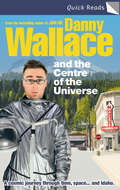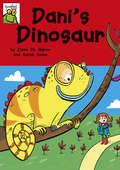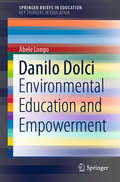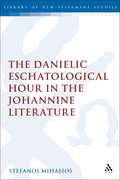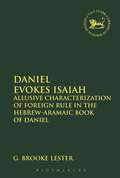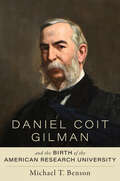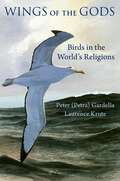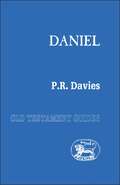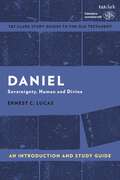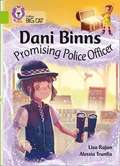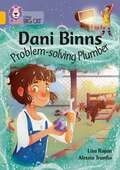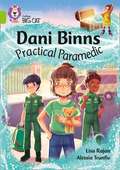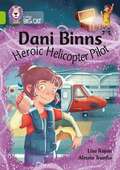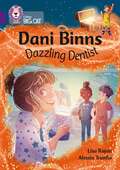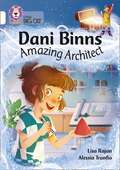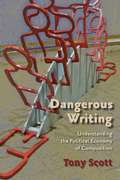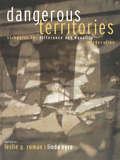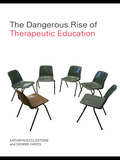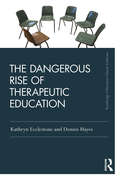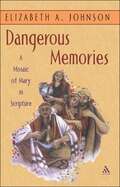- Table View
- List View
Danny Wallace and the Centre of the Universe
by Danny WallaceDanny Wallace wanted to write about a place so special and so crucial to our existence that it had never before been tackled: the Centre of the Universe. But then he realised that getting there might be a problem, and when he did, there'd probably be nothing much to write about. Until he heard about a manhole cover, on a small street, in a small town, tucked away in a remote part of Idaho.The manhole cover had been declared the Centre of the Universe. The mayor had the science to back it up. The town rejoiced.And the name of the town?Wallace.It was a cosmic coincidence Danny couldn't resist...
Dani's Dinosaur: Dani's Dinosaur Froglets: Dani's Dinosaur (Froglets #3)
by Clare De MarcoDani's Dinosaur is a funny story for young lizard and pet fans who are learning to read on their own. Perfect for children aged 5-7 who are reading at book band green.When Dani finds a dinosaur in her garden, she and her mum are very surprised. Whatever can it be? And can it help Mum with the gardening?The Froglets series is perfect for children who are reading on their own, with fun stories of no more than 200 words and puzzles to encourage retelling the story and to help build vocabulary. Compiled in consultation with Catherine Glavina, PGCE and Primary Leader, The Centre for Professional Education, University of Warwick.
Danilo Dolci: Environmental Education and Empowerment (SpringerBriefs in Education)
by Abele LongoThe book presents the multi-faceted opus of Danilo Dolci within the framework of Environmental Education, focusing on his work as a grassroots community educator, nonviolent activist and poet. It illustrates Dolci’s ‘Reciprocal Maieutic Approach’, a dialectic method of inquiry that can be defined as a process of collective exploration, taking as point of departure the experience, culture and intuition of individuals, ultimately directed towards the development of citizenship. Sessions led by Dolci in Sicily from the 1950s to the 1990s gave rise to the development of action plans that aimed to empower individuals, transform communities and, extending far beyond this, towards the planning and implementation of changes that would have a dramatic impact at a global and planetary level.
The Danielic Eschatological Hour in the Johannine Literature (The Library of New Testament Studies #436)
by Stefanos MihaliosStefanos Mihalios examines the uses of the 'hour' in the writings of John and demonstrates the contribution of Danielic eschatology to John's understanding of this concept.Mihalios begins by tracing the notion of an eschatological time in the Old Testament within expressions such as 'in that time' and 'time of distress,' which also appear in the book of Daniel and relate to the eschatological hour found in Daniel.Mihalios finds that even within the Jewish tradition there exists an anticipation of the fulfillment of the Danielic eschatological time, since the eschatological hour appears in the Jewish literature within contexts that allude to the Danielic end-time events. Mihalios moves on to examines the Johannine eschatological expressions and themes that have their source in Daniel, finding evidence of clear allusions whenever the word 'hour' arises.Through this examination, he concludes that for the Johannine Jesus use of the term 'hour' indicates that the final hour of tribulation and resurrection, as it is depicted in Daniel, has arrived.
Daniel Evokes Isaiah: Allusive Characterization of Foreign Rule in the Hebrew-Aramaic Book of Daniel (The Library of Hebrew Bible/Old Testament Studies #606)
by G. Brooke LesterLester argues here that the book of Daniel contains a complex but poetically unified narrative. This can be identified through certain narrative qualities, including the allusion to Isaiah throughout, which uniquely contributes to the narrative arc. The narrative begins with the inauguration of foreign rule over Israel, and concludes with that rule's end. Each stage of the book's composition casts that foreign rule in terms ever-more-reminiscent of Isaiah's depiction of Assyria. That enemy is first conscripted by God to punish Israel, but then arrogates punitive authority to itself until ultimately punished in its turn and destroyed. Each apocalypse in the book of Daniel carries forward, in its own way, that allusive characterization.Lester thus argues that an allusive poetics can be investigated as an intentional rhetorical trope in a work for which the concept of “author” is complex; that a narrative criticism can incorporate a critical understanding of composition history. The “Daniel” resulting from this inquiry depicts Daniel's 2nd-century Jewish reader not as suffering punishment for breaking covenant with God, but as enduring in covenant faithfulness the last days of the “Assyrian” arrogator's violent excesses. This narrative problematizes any simplistic narrative conceptions of biblical Israel as ceaselessly rebellious, lending a unique note to conversations about suffering and theodicy in the Hebrew Bible, and about anti-Judaic habits in Christian reading of the Hebrew Bible.
Daniel Coit Gilman and the Birth of the American Research University
by Michael T. BensonOne of the most remarkable education leaders of the late nineteenth century and the creator of the modern American research university finally gets his due.Daniel Coit Gilman, a Yale-trained geographer who first worked as librarian at his alma mater, led a truly remarkable life. He was selected as the third president of the University of California; was elected as the first president of Johns Hopkins University, where he served for twenty-five years; served as one of the original founders of the Association of American Universities; and—at an age when most retired—was hand-picked by Andrew Carnegie to head up his eponymous institution in Washington, DC.In Daniel Coit Gilman and the Birth of the American Research University, Michael T. Benson argues that Gilman's enduring legacy will always be as the father of the modern research university—a uniquely American invention that remains the envy of the entire world. In the past half-century, nothing has been written about Gilman that takes into account his detailed journals, reviews his prodigious correspondence, or considers his broad external board service. This book fills an enormous void in the history of the birth of the "new" American system of higher education, especially as it relates to graduate education. The late 1800s, Benson points out, is one of the most pivotal periods in the development of the American university model; this book reveals that there is no more important figure in shaping that model than Daniel Coit Gilman.Benson focuses on Gilman's time deliberating on, discussing, developing, refining, and eventually implementing the plan that brought the modern research university to life in 1876. He also explains how many university elements that we take for granted—the graduate fellowships, the emphasis on primary investigations and discovery, the funding of the best laboratory and research spaces, the scholarly journals, the university presses, the sprawling health sciences complexes with teaching hospitals—were put in place by Gilman at Johns Hopkins University. Ultimately, the book shows, Gilman and his colleagues forced all institutions to reexamine their own model and to make the requisite changes to adapt, survive, thrive, compete, and contribute.
Daniel Coit Gilman and the Birth of the American Research University
by Michael T. BensonOne of the most remarkable education leaders of the late nineteenth century and the creator of the modern American research university finally gets his due.Daniel Coit Gilman, a Yale-trained geographer who first worked as librarian at his alma mater, led a truly remarkable life. He was selected as the third president of the University of California; was elected as the first president of Johns Hopkins University, where he served for twenty-five years; served as one of the original founders of the Association of American Universities; and—at an age when most retired—was hand-picked by Andrew Carnegie to head up his eponymous institution in Washington, DC.In Daniel Coit Gilman and the Birth of the American Research University, Michael T. Benson argues that Gilman's enduring legacy will always be as the father of the modern research university—a uniquely American invention that remains the envy of the entire world. In the past half-century, nothing has been written about Gilman that takes into account his detailed journals, reviews his prodigious correspondence, or considers his broad external board service. This book fills an enormous void in the history of the birth of the "new" American system of higher education, especially as it relates to graduate education. The late 1800s, Benson points out, is one of the most pivotal periods in the development of the American university model; this book reveals that there is no more important figure in shaping that model than Daniel Coit Gilman.Benson focuses on Gilman's time deliberating on, discussing, developing, refining, and eventually implementing the plan that brought the modern research university to life in 1876. He also explains how many university elements that we take for granted—the graduate fellowships, the emphasis on primary investigations and discovery, the funding of the best laboratory and research spaces, the scholarly journals, the university presses, the sprawling health sciences complexes with teaching hospitals—were put in place by Gilman at Johns Hopkins University. Ultimately, the book shows, Gilman and his colleagues forced all institutions to reexamine their own model and to make the requisite changes to adapt, survive, thrive, compete, and contribute.
Daniel After Babylon: The Additions in the History of Interpretation (Reception of Old Testament Apocrypha)
by Jennie GrilloThe biblical book of Daniel was known to Jewish and Christian antiquity in its longer versions, preserved for us in the Greek textual tradition. Those Additions, as they came to be called (the tale of Susanna and the legends of Bel and the Dragon, the Prayer of Azariah and the Song of the Three Hebrews in the fiery furnace), have travelled on through languages and cultures and have generated long trails of interpretation, from commentary and religious iconography to fine art and domestic interiors. This book follows three particular trails in the reception of the longer Daniel-book, tracing the themes of martyrdom, afterlife worlds, and the act of seeing beauty. Recovering and documenting the voices of ancient, medieval, and modern interpreters, we meet an assembled cast of Jewish and Christian martyrs, liturgical subjects facing purgatory or paradise, and women resisting voyeuristic viewing. All this reception, though, is a route to reading the text of Greek Daniel itself: these later interpreters move this study towards exegetical conclusions about the Jewish roots of ancient martyrdom, the importance of the book of Daniel to the expansion of afterlife spaces within Second Temple Judaism, and a defense of the ethics of narration in the text of Susanna. Drawing on methods of material philology, Jennie Grillo argues for the central place of the Additions in the readerly history of the book of Daniel, and for this longer Daniel-book's abiding significance for theology.
Daniel (Old Testament Guides)
by Philip R. DaviesDaniel has engendered a good deal of controversial debate, especially regarding its date and authorship and its 'apocalyptic' character. In this introduction for the student, the scholarly issues are carefully described and assessed, while emphasis is placed on the literary and theological aspects of the book, which have been comparatively neglected, but which reflect the concerns and interests of contemporary Old Testament scholarship. This volume thus looks both at the past scholarship and points towards future trends in the understanding of a unique literary and theological masterpiece. It is provided with annotated bibliographies and indexes.
Daniel: An Introduction and Study Guide: Sovereignty, Human and Divine (T&T Clark’s Study Guides to the Old Testament)
by Ernest LucasIntroducing students to the Book of Daniel in the Old Testament, Ernest Lucas examines the book's structure and characteristics. He covers the latest in biblical scholarship, including historical and interpretive issues, and considers a range of scholarly approaches. Lucas shows how understanding of the book is enhanced by considering it in the context of Mesopotamian culture, literature, and religion. He also evaluates different arguments concerning the authorship, date, and provenance of the book.In particular, the guide focuses on illuminating the book's relationship to both the tradition of Hebrew prophecy and the later development of Jewish apocalyptic literature. It also highlights the importance of understanding the Book of Daniel as "resistance literature", which intended to encourage faithful Jews to resist the pressures of conformity to the pagan culture in which they lived, and to endure through persecution if necessary.With suggestions of further reading at the end of each chapter, this guide will be an essential accompaniment to study of the Book of Daniel.
Daniel: An Introduction and Study Guide: Sovereignty, Human and Divine (T&T Clark’s Study Guides to the Old Testament)
by Ernest LucasIntroducing students to the Book of Daniel in the Old Testament, Ernest Lucas examines the book's structure and characteristics. He covers the latest in biblical scholarship, including historical and interpretive issues, and considers a range of scholarly approaches. Lucas shows how understanding of the book is enhanced by considering it in the context of Mesopotamian culture, literature, and religion. He also evaluates different arguments concerning the authorship, date, and provenance of the book.In particular, the guide focuses on illuminating the book's relationship to both the tradition of Hebrew prophecy and the later development of Jewish apocalyptic literature. It also highlights the importance of understanding the Book of Daniel as "resistance literature", which intended to encourage faithful Jews to resist the pressures of conformity to the pagan culture in which they lived, and to endure through persecution if necessary.With suggestions of further reading at the end of each chapter, this guide will be an essential accompaniment to study of the Book of Daniel.
Dani Binns Promising Police Officer: Band 11/Lime (Collins Big Cat)
by Lisa Rajan Alessia Trunfio Collins Big CatWhen Dani Binns opens up her toy box something exciting happens … Dani Binns is a police officer! Several thefts have been reported at the town market – a silver bracelet, a set of keys, some coins, and a badge have all gone missing. But who has taken them? Dani and her fellow police officers, Asha and Tai, have their suspicions, but the clues seem to lead down a different path. Will Dani find the real culprit? This exciting title in the Dani Binns mini-series is written by Lisa Rajan. Lime/Band 11 books have longer sentence structures and a greater use of literary language. Ideas for reading in the back of the book provide practical support and stimulating activities.
Dani Binns Problem-solving Plumber (Collins Big Cat)
by Lisa RajanCollins Big Cat supports every primary child on their reading journey from phonics to fluency. Top authors and illustrators have created fiction and non-fiction books that children love to read. Levelled for guided and independent reading, each book includes ideas to support reading. Teaching and assessment support and eBooks are also available.
Dani Binns Practical Paramedic: Band 11/Lime (Collins Big Cat)
by Lisa Rajan Alessia Trunfio Collins Big CatWhen Dani Binns opens up her toy box something exciting happens … Dani Binns is a paramedic! She finds herself in an ambulance speeding to the scene of an accident. A girl has fallen off a bike in the street and hurt herself. After an assessment by Dani and the team, she seems OK. But why did she fall off the bike in the first place… and who is this ‘Benny’ she keeps asking about? This exciting title in the Dani Binns mini-series is written by Lisa Rajan. Lime/Band 11 books have longer sentence structures and a greater use of literary language. Ideas for reading in the back of the book provide practical support and stimulating activities.
Dani Binns Heroic Helicopter Pilot (Collins Big Cat)
by Lisa RajanCollins Big Cat supports every primary child on their reading journey from phonics to fluency. Top authors and illustrators have created fiction and non-fiction books that children love to read. Levelled for guided and independent reading, each book includes ideas to support reading. Teaching and assessment support and eBooks are also available.
Dani Binns Dazzling Dentist (Collins Big Cat)
by Lisa RajanCollins Big Cat supports every primary child on their reading journey from phonics to fluency. Top authors and illustrators have created fiction and non-fiction books that children love to read. Levelled for guided and independent reading, each book includes ideas to support reading. Teaching and assessment support and eBooks are also available.
Dani Binns Amazing Architect (Collins Big Cat)
by Lisa RajanCollins Big Cat supports every primary child on their reading journey from phonics to fluency. Top authors and illustrators have created fiction and non-fiction books that children love to read. Levelled for guided and independent reading, each book includes ideas to support reading. Teaching and assessment support and eBooks are also available.
Dangerous Writing: Understanding the Political Economy of Composition
by Tony ScottBuilding on recent work in rhetoric and composition that takes an historical materialist approach, Dangerous Writing outlines a political economic theory of composition. The book connects pedagogical practices in writing classes to their broader political economic contexts, and argues that the analytical power of students’ writing is prevented from reaching its potential by pressures within the academy and without, that tend to wed higher education with the aims and logics of “fast-capitalism.” Since the 1980s and the “social turn” in composition studies and other disciplines, scholars in this field have conceived writing in college as explicitly embedded in socio-rhetorical situations beyond the classroom. From this conviction develops a commitment to teach writing with an emphasis on analyzing the social and political dimensions of rhetoric. Ironically, though a leftist himself, Tony Scott’s analysis finds the academic left complicit with the forces in American culture that tend, in his view, to compromise education. By focusing on the structures of labor and of institutions that enforce those structures, Scott finds teachers and administrators are too easily swept along with the inertia of a hyper-commodified society in which students---especially working class students---are often positioned as commodities, themselves. Dangerous Writing, then, is a critique of the field as much as it is a critique of capitalism. Ultimately, Scott’s eye is on the institution and its structures, and it is these that he finds most in need of transformation.
Dangerous Territories: Struggles for Difference and Equality in Education
by Leslie G. Roman Linda EyreWith the recent conservative retrenchment, educational institutions have witnessed a backlash against the gains made by feminist and antiracist activists. Dangerous Territories examines higher education as one site of this backlash, at the same time challenging the binary framing of discourse as "reactionary" vs. "progressive," or Right vs. Left. Contributors are scholars working within and across a variety of disciplines including law, history, sociology, education, literature, women's studies, queer theory, cultural politics and postcolonialism.
Dangerous Territories: Struggles for Difference and Equality in Education
by Leslie G. Roman Linda EyreWith the recent conservative retrenchment, educational institutions have witnessed a backlash against the gains made by feminist and antiracist activists. Dangerous Territories examines higher education as one site of this backlash, at the same time challenging the binary framing of discourse as "reactionary" vs. "progressive," or Right vs. Left. Contributors are scholars working within and across a variety of disciplines including law, history, sociology, education, literature, women's studies, queer theory, cultural politics and postcolonialism.
The Dangerous Rise of Therapeutic Education
by Kathryn Ecclestone Dennis HayesThe silent ascendancy of a therapeutic ethos across the education system and into the workplace demands a book that serves as a wake up call to everyone. Kathryn Ecclestone and Dennis Hayes' controversial and compelling book uses a wealth of examples across the education system, from primary schools to university, and the workplace to show how therapeutic education is turning children, young people and adults into anxious and self-preoccupied individuals rather than aspiring, optimistic and resilient learners who want to know everything about the world. The chapters address a variety of thought-provoking themes, including how therapeutic ideas from popular culture dominate social thought and social policies and offer a diminished view of human potential how schools undermine parental confidence and authority by fostering dependence and compulsory participation in therapeutic activities based on disclosing emotions to others how higher education has adopted therapeutic forms of teacher training because many academics have lost faith in the pursuit of knowledge how such developments are propelled by a deluge of political initiatives in areas such as emotional literacy, emotional well-being and the 'soft outcomes' of learning The Dangerous Rise of Therapeutic Education is eye-opening reading for every teacher, student teacher and parent who retains any belief in the power of knowledge to transform people's lives. Its insistent call for a serious public debate about the emotional state of education should also be at the forefront of the minds of every agent of change in society... from parent to policy maker.
The Dangerous Rise of Therapeutic Education
by Kathryn Ecclestone Dennis HayesThe silent ascendancy of a therapeutic ethos across the education system and into the workplace demands a book that serves as a wake up call to everyone. Kathryn Ecclestone and Dennis Hayes' controversial and compelling book uses a wealth of examples across the education system, from primary schools to university, and the workplace to show how therapeutic education is turning children, young people and adults into anxious and self-preoccupied individuals rather than aspiring, optimistic and resilient learners who want to know everything about the world. The chapters address a variety of thought-provoking themes, including how therapeutic ideas from popular culture dominate social thought and social policies and offer a diminished view of human potential how schools undermine parental confidence and authority by fostering dependence and compulsory participation in therapeutic activities based on disclosing emotions to others how higher education has adopted therapeutic forms of teacher training because many academics have lost faith in the pursuit of knowledge how such developments are propelled by a deluge of political initiatives in areas such as emotional literacy, emotional well-being and the 'soft outcomes' of learning The Dangerous Rise of Therapeutic Education is eye-opening reading for every teacher, student teacher and parent who retains any belief in the power of knowledge to transform people's lives. Its insistent call for a serious public debate about the emotional state of education should also be at the forefront of the minds of every agent of change in society... from parent to policy maker.
The Dangerous Rise of Therapeutic Education
by Kathryn Ecclestone Dennis HayesThe Dangerous Rise of Therapeutic Education confronts the silent ascendancy of a therapeutic ethos across the educational system and into the workplace. Controversial and compelling, Kathryn Ecclestone and Dennis Hayes’ classic text uses a wealth of examples across the education system, from primary schools to university and the workplace, to show how therapeutic education is turning children, young people and adults into anxious and self-preoccupied individuals rather than aspiring, optimistic and resilient learners who want to know everything about the world. Remaining extremely topical, the chapters illuminate the powerful effects of therapeutic education, including: How therapeutic learning is taking shape, now and in the future How therapeutic ideas from popular culture have come to govern social thought and policies How the fostering of dependence and compulsory participation in therapeutic activities that encourage the disclosing of emotions, can undermine parents’ and teachers’ confidence and authority How therapeutic forms of teacher training undermine faith in the pursuit of knowledge How political initiatives in emotional literacy, emotional wellbeing and ‘positive mental health’ propagate a diminished view of human potential throughout the education system and the workplace. The Dangerous Rise of Therapeutic Education is an eye-opening read for every teacher and leader across the field of education, and every parent and student, who is passionate about the power of knowledge to transform people’s lives. It is a call for a debate about the growing impact of therapeutic education and what it means for learning now and in the future.
The Dangerous Rise of Therapeutic Education
by Kathryn Ecclestone Dennis HayesThe Dangerous Rise of Therapeutic Education confronts the silent ascendancy of a therapeutic ethos across the educational system and into the workplace. Controversial and compelling, Kathryn Ecclestone and Dennis Hayes’ classic text uses a wealth of examples across the education system, from primary schools to university and the workplace, to show how therapeutic education is turning children, young people and adults into anxious and self-preoccupied individuals rather than aspiring, optimistic and resilient learners who want to know everything about the world. Remaining extremely topical, the chapters illuminate the powerful effects of therapeutic education, including: How therapeutic learning is taking shape, now and in the future How therapeutic ideas from popular culture have come to govern social thought and policies How the fostering of dependence and compulsory participation in therapeutic activities that encourage the disclosing of emotions, can undermine parents’ and teachers’ confidence and authority How therapeutic forms of teacher training undermine faith in the pursuit of knowledge How political initiatives in emotional literacy, emotional wellbeing and ‘positive mental health’ propagate a diminished view of human potential throughout the education system and the workplace. The Dangerous Rise of Therapeutic Education is an eye-opening read for every teacher and leader across the field of education, and every parent and student, who is passionate about the power of knowledge to transform people’s lives. It is a call for a debate about the growing impact of therapeutic education and what it means for learning now and in the future.
Dangerous Memories: A Mosaic of Mary in Scripture
by Elizabeth A. JohnsonElizabeth Johnson takes the 13 gospel appearances of Mary of Nazareth and creates a rich, deep Marian identity from this complex mosaic. Dangerous Memories is taken from her acclaimed Truly Our Sister: A Theology of Mary in the Communion of Saints (0-8264-1473-7), with the addition of a new introduction and a short annotated bibliography.
